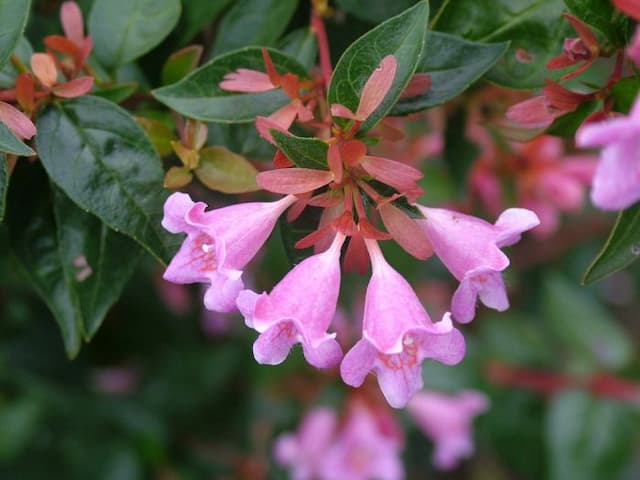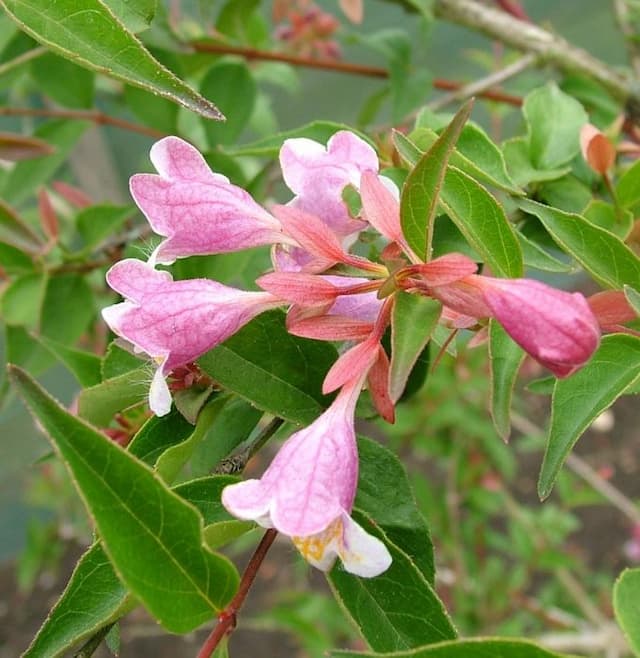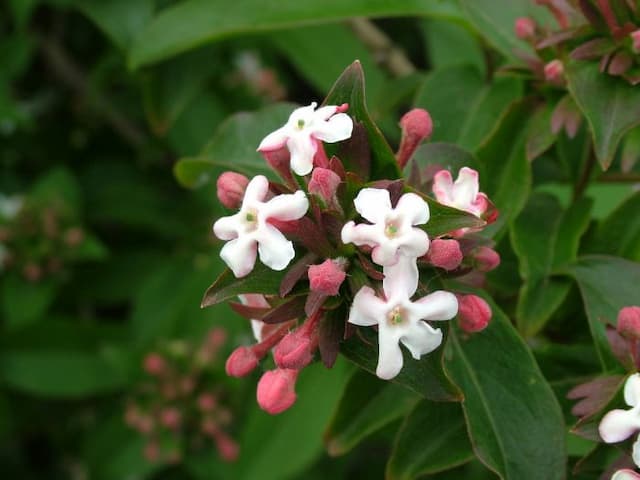Yunnan Honeysuckle Lonicera ligustrina var. yunnanensis 'Twiggy' (v)

ABOUT
The Lonicera ligustrina var. yunnanensis 'Twiggy', commonly known as the Twiggy honeysuckle, is a visually appealing plant with distinctive characteristics that contribute to its unique charm. This variant of honeysuckle is admired for its foliage and overall form. The leaves of the Twiggy honeysuckle are lush and dense, presenting an attractive green hue that functions as a perfect backdrop for its flowers. Upon closer inspection, one can observe the intricate vein patterns etched across the leaf surface, adding to the plant's ornate look. The leaves are arranged oppositely on the twigs, creating a sense of symmetry that enhances the plant’s visual appeal. In terms of flowering, the Twiggy honeysuckle produces delicate flowers that can be a joy to observe. The blossoms often exhibit a vibrant color, and their shape may possess a charming appeal that attracts various pollinators. Moreover, this particular honeysuckle is known for its branching structure that contributes to an interesting silhouette, especially when the plant is not laden with leaves. The stems might appear slender and may arch gracefully, giving the plant an elegant posture. These attributes could contribute to the plant's popularity in horticultural circles, where it might be utilized for both its aesthetic qualities and its ability to create a sense of texture and depth within a garden setting.
About this plant
 Names
NamesFamily
Caprifoliaceae.
Synonyms
Yunnan Honeysuckle, Twiggy Box Honeysuckle, Dwarf Honeysuckle.
Common names
Lonicera ligustrina var. yunnanensis 'Twiggy'.
 Toxicity
ToxicityTo humans
The plant commonly known as Twiggy honeysuckle, belonging to the genus Lonicera, has species that are often toxic to humans if ingested. While this specific variety, Lonicera ligustrina var. yunnanensis 'Twiggy', does not have well-documented cases of poisoning, related species have parts that contain saponins or glycosides which can cause symptoms if ingested. Typical symptoms of honeysuckle poisoning may include stomach upset, diarrhea, rapid heartbeat, and vomiting. Severe poisoning could potentially lead to more serious consequences, but such outcomes are rare in humans due to the unpleasant taste of the plant usually deterring significant consumption.
To pets
The Twiggy honeysuckle can be toxic to pets if ingested, similar to its effects on humans. While there is not as much specific information about the toxicity of Lonicera ligustrina var. yunnanensis 'Twiggy', pets that consume parts of related honeysuckle species may experience symptoms such as diarrhea, vomiting, and abdominal pain. Ingestion of significant amounts could lead to more serious health issues. The actual risk may vary based on the amount ingested and the size and health of the pet. It is advisable to keep pets from consuming this plant and to consult a veterinarian if ingestion occurs.
 Characteristics
CharacteristicsLife cycle
Perennials
Foliage type
Deciduous
Color of leaves
Green
Flower color
Yellow
Height
6 feet (1.83 meters)
Spread
6 feet (1.83 meters)
Plant type
Shrub
Hardiness zones
6
Native area
China
Benefits
 General Benefits
General Benefits- Attractive to Wildlife: The flowers of 'Twiggy' provide nectar to pollinators such as bees and butterflies, promoting biodiversity.
- Low Maintenance: This shrub is known for requiring minimal care once established, making it suitable for gardeners of all skill levels.
- Drought Tolerance: 'Twiggy' can survive with less water than many plants, making it appropriate for xeriscaping or low-water gardens.
- Ornamental Appeal: With its lush foliage and graceful form, 'Twiggy' adds visual interest to the landscape throughout the growing season.
- Adaptability: It can thrive in a variety of soil types as long as there is good drainage, enabling it to be planted in diverse settings.
- Seasonal Interest: This variety may offer different colors and textures through the seasons, with foliage and blooming flowers.
 Medical Properties
Medical PropertiesThis plant is not used for medical purposes.
 Air-purifying Qualities
Air-purifying QualitiesThis plant is not specifically known for air purifying qualities.
 Other Uses
Other Uses- Privacy Screening: Due to its dense foliage, Twiggy can be pruned into an informal hedge, providing natural privacy in gardens and landscapes.
- Topiary Art: The flexible growth pattern of Twiggy makes it suitable for topiary designs, where gardeners can shape it into various forms for aesthetic purposes.
- Wildlife Shelter: The dense branches can offer shelter for small wildlife like birds and beneficial insects, creating a safe haven within a garden setting.
- Erosion Control: Twiggy's root system can help stabilize soil on slopes, preventing erosion and maintaining the integrity of landscaping designs.
- Photography Background: The plant's texture and color provide a pleasing backdrop for outdoor photography, especially when the plant is blooming.
- Urban Gardening: Twiggy's adaptability to container life makes it suitable for balconies and terraces, bringing greenery to urban environments.
- Seasonal Decor: Twiggy's branches can be harvested and used for making wreaths or other decorative items, especially in the fall when leaves change color.
- Educational Tool: Twiggy can be used in educational settings like schools or nature centers to teach pruning techniques and plant growth habits.
- Nature-Inspired Art: Artists can use Twiggy as a reference or inspiration for nature drawings, paintings, and other forms of botanical art.
- Childhood Engagement: Twiggy can be incorporated into children's gardens, offering a tactile experience as kids learn about plants and engage with nature.
Interesting Facts
 Feng Shui
Feng ShuiThe plant_name is not used in Feng Shui practice.
 Zodiac Sign Compitability
Zodiac Sign CompitabilityThe plant_name is not used in astrology practice.
 Plant Symbolism
Plant Symbolism- Devotion: The honeysuckle is often associated with devoted love and affection, as its twining vines represent close bonds and attachment.
- Happiness: In some cultures, honeysuckle can symbolize happiness due to its sweet scent and joyful clusters of flowers bringing to mind the delights of summer.
- Fidelity: Because honeysuckle plants can remain entwined for years, they sometimes represent fidelity and enduring relationships.
- Protection: Honeysuckle can also symbolize protection, as it grows densely and can often be used to shield and cover structures in the landscape.
- Generosity: The abundant nectar of honeysuckle flowers, which attracts pollinators, can be seen as a symbol of generosity and the willingness to give freely to others.
 Water
WaterThe Yunnan Honeysuckle 'Twiggy' should be watered when the top inch of the soil feels dry to the touch, which typically corresponds to once every week, but this may vary depending on climate and season. Use a watering can or hose to water at the base of the plant, avoiding wetting the foliage to minimize the risk of disease. The plant generally thrives with about 1 gallon of water per watering session, ensuring that the soil is moist but not waterlogged. During the active growing season in spring and summer, you may need to water more frequently, especially in hot, dry weather.
 Light
LightYunnan Honeysuckle 'Twiggy' grows best in full sun to partial shade conditions. It should be placed in a location that receives at least 4 to 6 hours of direct sunlight daily, which encourages healthy growth and abundant flowering. An eastern or western exposure is ideal to provide bright light with some protection from the intense midday sun.
 Temperature
TemperatureYunnan Honeysuckle 'Twiggy' prefers a temperature range of 60 to 75 degrees Fahrenheit for optimal growth. It can tolerate a minimum temperature of about 20 degrees Fahrenheit but should be protected from frost to prevent damage to the plant. The ideal growing conditions are warm days with cooler nighttime temperatures.
 Pruning
PruningPruning the Yunnan Honeysuckle 'Twiggy' is important to maintain its shape, encourage new growth, and remove any dead or diseased branches. The best time to prune is in late winter or early spring before new growth starts. Prune lightly to shape the plant and remove any unwanted growth, doing so annually or biannually as needed.
 Cleaning
CleaningAs needed
 Soil
SoilThe best soil mix for the Yunnan Honeysuckle 'Twiggy' should be well-draining and fertile, with a composition similar to loamy garden soil enriched with compost and a small amount of peat for moisture retention. The ideal pH for this shrub is between 6.0 and 7.5, slightly acidic to neutral.
 Repotting
RepottingYunnan Honeysuckle 'Twiggy' should be repotted every two to three years or when it outgrows its current pot. Repotting is best done in the early spring before the onset of new growth.
 Humidity & Misting
Humidity & MistingYunnan Honeysuckle 'Twiggy' prefers moderate humidity levels; aim to maintain relative humidity around 50-60% for optimal growth.
 Suitable locations
Suitable locationsIndoor
Provide bright, indirect light and monitor moisture.
Outdoor
Plant in partial shade, shelter from strong winds, well-draining soil.
Hardiness zone
5-9 USDA
 Life cycle
Life cycleThe Lonicera ligustrina var. yunnanensis 'Twiggy', commonly known as the Yunnan Honeysuckle 'Twiggy', begins its life cycle with seed germination, usually in spring under the correct moist and temperature conditions. Following germination, the seedling emerges and develops primary leaves, and over time establishes a root system. As it enters the vegetative growth stage, it develops a woody stem and more complex leaf structures for photosynthesis, often maturing over several years. This shrub will then enter a period of reproductive maturity, producing flowers that are typically pollinated by insects, leading to the development of berries which encase the seeds. After dispersal, often by birds that feed on the berries, seeds enter the environment to potentially start a new life cycle. The honeysuckle may live for many years, going through seasonal cycles of flowering and dormancy, and can spread through clonal propagation from layering of its branches.
 Propogation
PropogationPropogation time
Spring-Early Summer
Lonicera ligustrina var. yunnanensis 'Twiggy', more commonly known as the Yunnan Honeysuckle, is often propagated by semi-hardwood cuttings. The ideal time for taking cuttings is during the late summer, as this is when the current season's growth has matured enough yet still retains some flexibility. To propagate, a gardener would select a healthy, disease-free branch and cut a segment approximately 4 to 6 inches (10 to 15 centimeters) long, making sure that there are several sets of leaves. The lower leaves are typically removed, and the cut end is often treated with a rooting hormone powder or gel to encourage root development. The prepared cutting is then inserted into a pot filled with a well-draining potting mix, ensuring that at least one set of leaf nodes is below the surface. The environment should be kept humid, and the soil consistently moist, but not waterlogged, until roots have successfully formed and new growth appears, indicating that the cutting has established.








![Himalayan honeysuckle [Golden Lanterns]](/_next/image?url=https%3A%2F%2Fplants-admin.emdemapps.com%2Fimages%2Fplants%2F%2Fimages%2F604b55302cc87.png&w=640&q=75)
